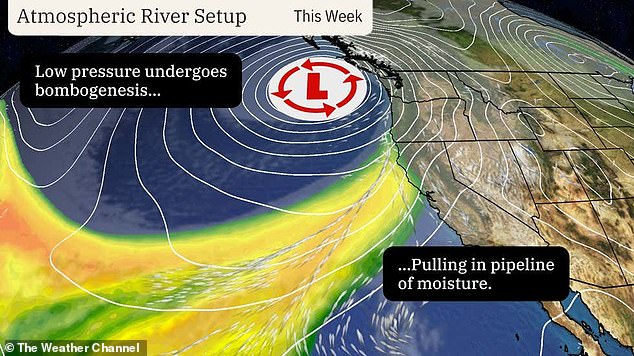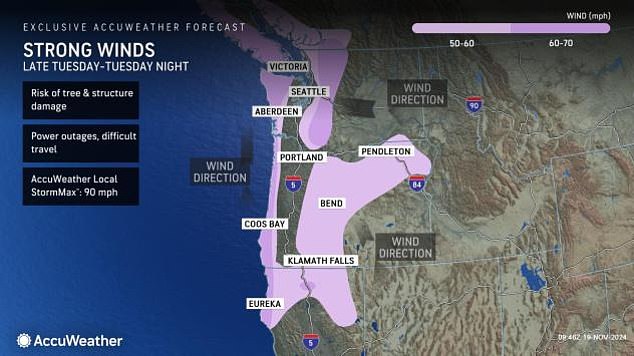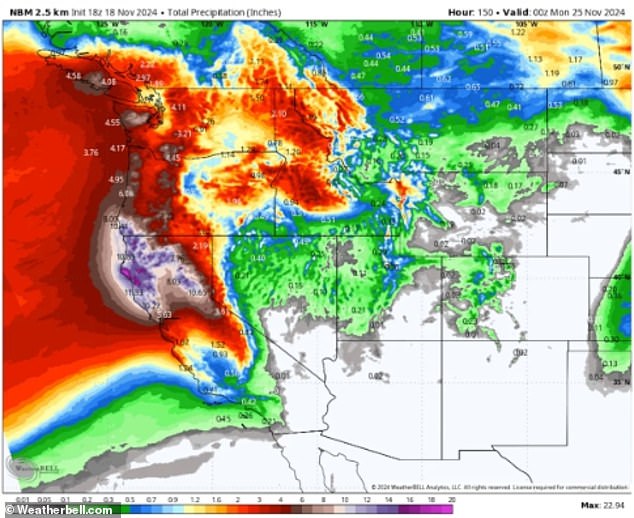What is a ‘bomb cyclone’ and how does it occur? An urgent warning is issued in three western states
A powerful storm is heading towards the west coast, which weather enthusiasts have dubbed a ‘bomb cyclone’.
The term “bomb cyclone” refers to any mid-latitude cyclone that has undergone “bombogenesis,” or a rapid increase in strength or size over 24 hours, according to the National Oceanic and Atmospheric Administration (NOAA).
The storm occurs when a cold air mass collides with a warm air mass, which usually happens over ocean waters, the agency shared.
Storm intensity is measured by central pressure – the lower the pressure, the stronger – and is considered a ‘bomb’ when the pressure drops rapidly to at least 24 millibars in 24 hours.
Meteorologist Ryan Maue said the central pressure of the coming bomb cyclone will drop nearly 70 millibars in 24 hours, reaching pressure levels comparable to a Category 4 hurricane.
The National Weather Service (NWS) warned residents in Northern California, Oregon and Washington this week of possible hurricane force winds, catastrophic flooding and several feet of snowfall at high elevations, with impacts starting Tuesday.
This super-charged storm will bring winds of up to 75 miles per hour and bring a Category 5 atmospheric river onto land, dumping up to 20 inches of rain in certain areas.
The term “bomb cyclone” refers to any mid-latitude cyclone that has undermined “bombogenesis” or rapid intensification over a 24-hour period
A wind projection map showed gusts between 60 and 70 miles per hour from Eureka to Coos Bay and along the coast north of Aberdeen.
Places like Klamath Falls, Bend and Penleton, and Seattle, Washington, Oregon can expect winds of between 50 and 60 miles per hour.
A precipitation map predicts precipitation could reach up to two inches in north-central and northwest California, western Oregon and western Washington, and up to 20 inches in northeastern California.
About 40 to 50 “bomb cyclones” form each year worldwide, but most are over the open ocean and no one except weather geeks notice, Maue said.
AccuWeather Senior Meteorologist Alex Sosnowski shared, “The term bombogenesis comes from the combination of two words: bomb and cyclogenesis.
‘All storms are cyclones, and arising means creation or beginning. In this case, bomb refers to explosive development and in its entirety the term means explosive storm strengthening.”
A cyclone is a large air mass rotating around a central point of low pressure.
In the Northern Hemisphere they rotate counterclockwise and in the Southern Hemisphere they rotate clockwise and are therefore called ‘anticyclones’.
A cyclone can undergo bombogenesis when it encounters a mass of warm, moist air, creating a significant temperature difference between the storm and its surroundings.
Above that temperature contrast, a powerful, increasing jet stream disturbance forces the air to rise, and this kicks off the bombogenesis process as the cyclone’s central pressure plummets, according to The Weather Channel.

A bomb cyclone is currently forming off the coasts of Washington, Oregon and Northern California, and is expected to draw an atmospheric river onshore as it intensifies
That’s because rising air creates a vacuum effect, resulting in lower atmospheric pressure.
These intense storms typically form in winter and are more common on the east coast of the US, where about one bomb cyclone can be found per year.
But they can form anywhere along the US coast.
The term “bomb cyclone” can also be used to describe tropical storms that are rapidly strengthening. Hurricane Milton – which grew from Category 1 to Category 5 within a 24-hour period before slamming into Florida – was an example of bombogenesis.

A wind projection map showed gusts between 60 and 70 miles per hour from Eureka to Coos Bay and along the coast north of Aberdeen. Places like Klamath Falls in Oregon, Bend and Penleton and Seattle in Washington can expect winds of between 50 and 60 miles per hour

The combined force of the bomb cyclone and the atmospheric river will drop heavy rainfall across the western states, with weekly totals of up to 20 inches in northwestern California.
The impact of this bomb cyclone will be exacerbated by an atmospheric river – a long and narrow part of the atmosphere that transports heat and moisture from the tropics to the Earth’s poles.
The cyclone will bring a Category 5 atmospheric river to the northwest coast. A Category 5 is exceptionally dangerous and causes intense storm effects on land.
Extreme storm systems like this bomb cyclone are likely fueled by human-induced climate change in a number of ways, according to the Union of Concerned Scientists.
First, rising ocean temperatures are creating a greater contrast between temperatures over land and the temperature of Arctic air moving south. Storms feed on this ever-widening difference.
In addition, increasing evaporation from land, caused by rising global temperatures, is pumping the atmosphere full of water vapor. When that vapor condenses into clouds, it releases latent heat, which storms use as fuel.
Increased water vapor also provides more moisture for storms, resulting in more frequent heavy precipitation events.
Climate change is also increasing the number of days the western US will experience atmospheric rivers, according to the US Department of Agriculture.
And as warming air and ocean temperatures provide more fuel to make the rivers in the atmosphere bigger and stronger, they will also become more dangerous.
